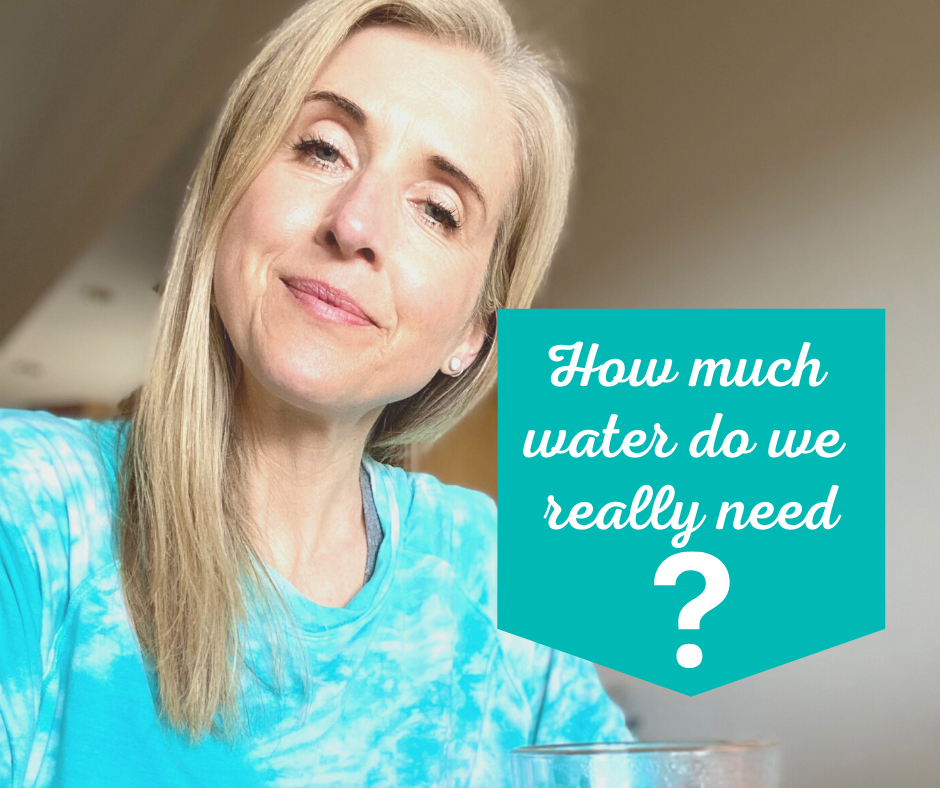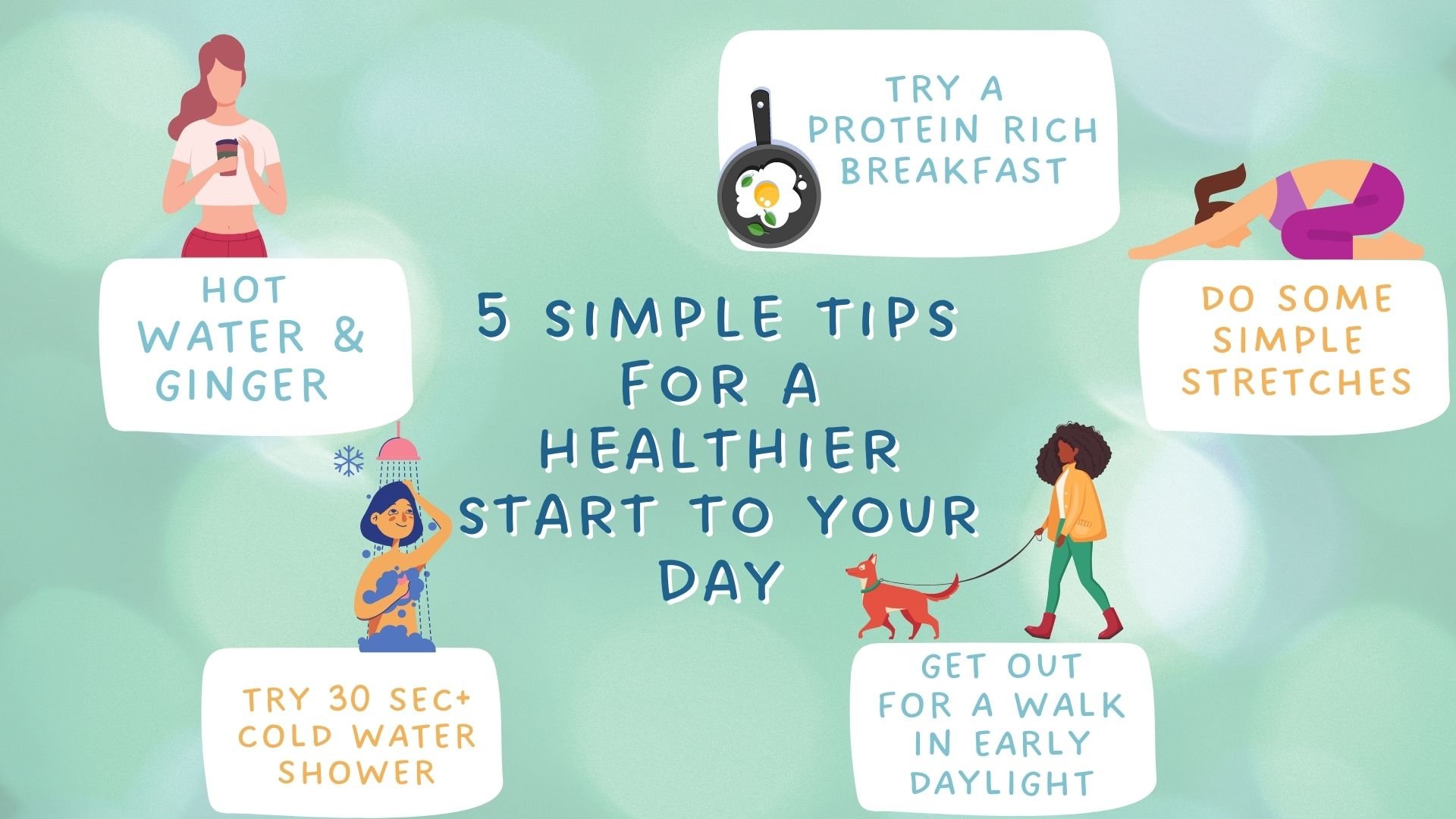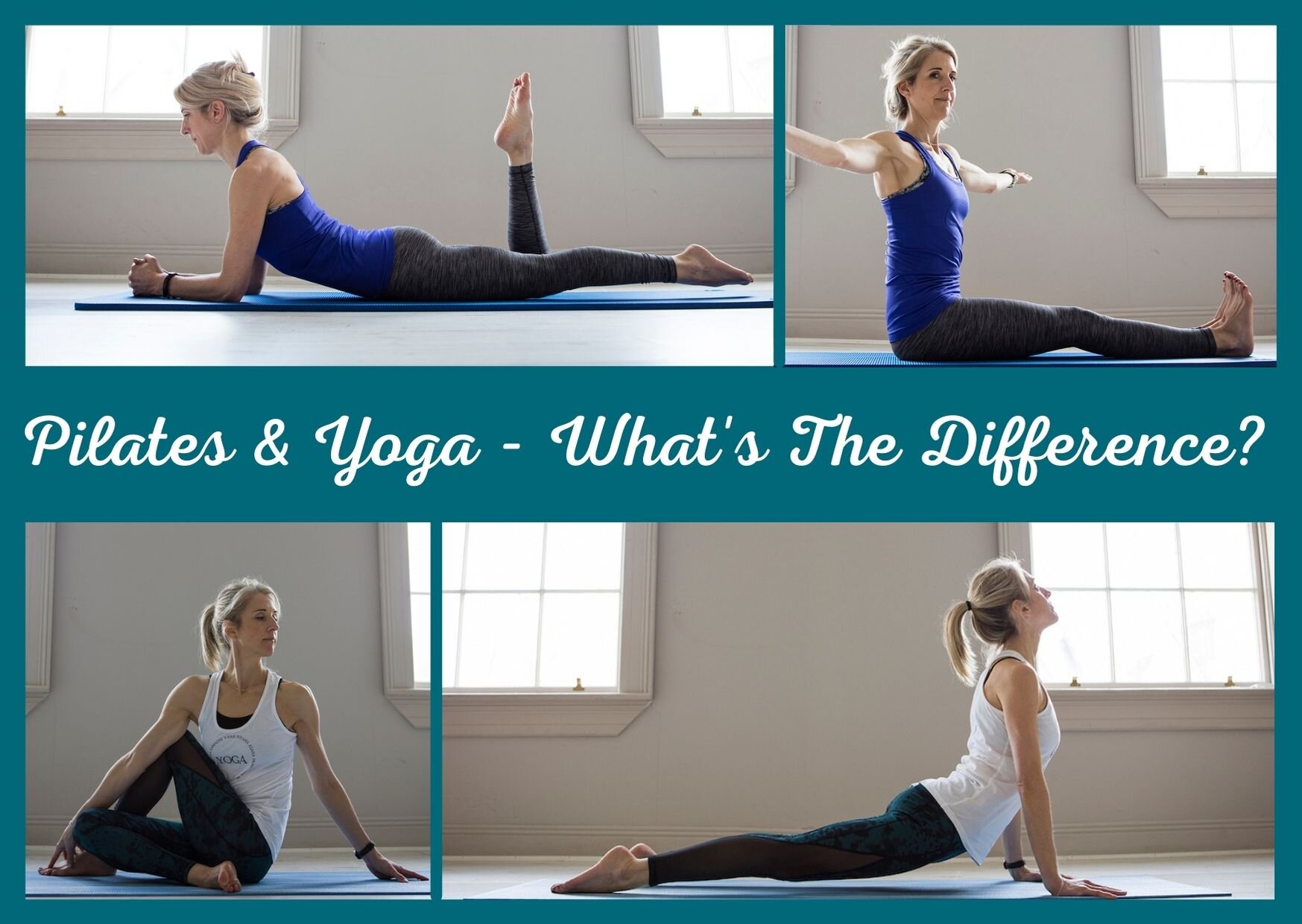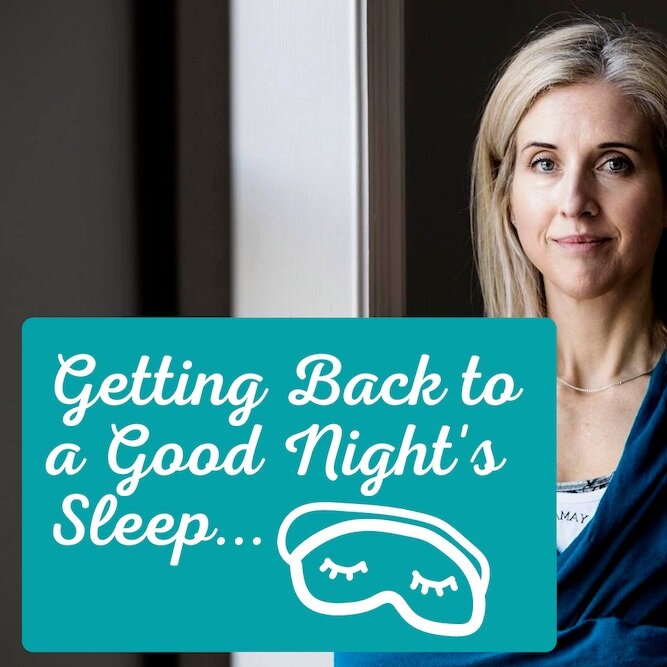Do we really need 8 x 8 glasses of water a day? Increasingly experts are saying no…
Read more5 Simple Tips For A Healthy Start To Your Day
Now I realise that not everybody is naturally a morning person, so it might be enough to just drag yourself out of bed rather than adding items to your list of things to do in the morning, but these measures are very simple and each one can help enhance your day.
1) Hot / warm water and ginger first thing
Ginger is great for our digestive system, it also has anti-oxidant, anti-bacterial and anti-inflammatory properties . I keep a jar of peeled, chopped ginger in the fridge, I have a big beer tankard that I pop it into first thing in the morning, I then try and drink the whole thing before my first class / client appointment, which doesn’t always happen, but when it does I feel smugly hydrated. I keep it topped up with hot water throughout the day. Most of the nutrients are just inside the skin, so try to lightly peel rather than chop too much of it away.
2) Consider including protein in your breakfast
It’s important we get enough protein in our diet. Protein is involved in building and repair in the body and is vital for healthy muscles and bones. From mid / late 30s onwards we start to lose muscle and bone, women in particular during perimenopause / menopause are effected by the depletion of oestrogen and need to be mindful of their bone mineral density. Eggs are the gold standard of protein and a perfect breakfast option (if you like eggs!). Protein, as well as providing material for muscles and bones, will keep you satiated for longer and you won’t get that energy peak and drop that you can get from many processed cereals and juices*. Can’t do the eggs? Porridge also fairs well on the protein front and you can add some seeds and a dollop of live natural yogurt which contains protein and healthy bacteria to benefit your gut.
*With cereals and juices check out the ‘sugar’ from carbs on the ingredients label. A breakfast high in sugar may provide a satisfying energy surge straight after eating but can leave us feeling hungry or sluggish mid-morning once that surge subsides. E.g. Flahavans porridge contains .9g sugars from carbs per 100g whereas Special K contains 15g sugar from carbohydrates per 100g.
3) Cold water showers
If you’re not into early morning sea swims, 30 sec to 2 minutes of cold water add the end of your shower can actually have similar health-enhancing benefits – helping to boost the immune system, as well as energy and mood. Research is starting to show that cold habituation decreases inflammatory responses over time. So try a quick cold blast at the end of your nice steamy shower, perhaps not quite as sociable as the sea swims, but certainly easier and convenient. And just for the record, I’m totally into early morning sea swims…mid-summer…in Greece.
4) A brisk morning walk
Getting out for a brisk walk in morning light can actually help improve your sleep, boost your mood (helping to offset the effects of SAD in the winter) and cut your risk of heart disease and diabetes.
Any form of walking outside during the day is good, but going in the morning is like a gentle alarm to let our body and brain know that the day has started. Light helps reset our body clock, which in turn tells our body when to go to sleep and when to wake up. The earlier you have exposure to daylight the better for your sleep, possibly even making it deeper with less chance of waking up. Light exposure also triggers the release of serotonin which is a feel good hormone, helping to boost our mood. Brisk walk = moderate-intensity exercise where our heart is beating a little faster, we’re breathing a little heavier but we can still hold a conversation.
5) Some Gentle Stretches
Simple stretches, the likes of child’s pose, lying on your back and hugging your knees to your chest and figure 4 stretch are all lovely and simple stretches to do in the morning to help stretch the muscles around hips and lower back.
Yoga & Pilates - What's the Difference?
‘What’s the difference between Yoga & Pilates?’ is a question I am asked quite often. I sat down yesterday morning with the intention of writing a few words explaining the differences between Pilates and yoga. Who I was I kidding? Even though I tried to stick to the basics and keep it as simple as possible, including sticking with Pilates matwork, it still took me nearly two days to finish.
Origins
Yoga
The origins of Yoga (meaning ‘yoke’ or ‘union’) can be traced back to 5,000 years (or 10,000 depending on who you ask) ago in Northern India to the Vedas (or Rig Veda) a collection of sacred poems and hymns where yoga was first referenced. Yoga progressed through the ages from what was originally a meditative and spiritual practice to incorporate asana ‘physical’ practice the discipline of ‘Hatha yoga’. In the early 1900s, the Indian yoga teacher Krishnamacharya revolutionised the teaching of yoga. He and his protegés have greatly influenced how yoga is perceived and taught in the western world.
Pilates
Joseph Pilates (1883 – 1967) developed the Pilates technique (initally called ‘contrology’) in the 20th century. Originally from Germany he started to develop his technique when he was interned on the Isle of Man during the first world war. After the war he moved to New York where he set up his first studio with his wife Clara in 1926. He used Pilates apparatus – specially made machines (what we know now as reformers, the barrel, Cadillac etc.) and to begin with many dancers came to his studio to rehabilitate injuries. Passionate about physical fitness and his method, by all accounts he was quite a character. He worked with and trained a group of teachers known as ‘The Elders’ who passed on his technique.
How Do Yoga & Pilates Classes Differ?
Yoga
Generally speaking – a standard studio class will very often involve an introduction with some guided meditation, a warm-up, possibly a sun salutation followed by a series of standing, seated and lying poses, which can all include forward folds, twists, backbends. Possibly some breathwork and always relaxation ‘savasana’ at the end.
You might be flowing through the poses quite quickly or holding them for a particular breath count. Breath focus is always encouraged, some teachers may use chanting e.g. ‘Om’ which is a beautiful addition to any class. There are 84 classical yoga asana and many many variations.
Pilates
One of the differences between yoga and Pilates is with Pilates you are almost continuously moving in time with the breath. Often you will be maintaining stability through the trunk – using your core strength - while moving the arms and/or legs dynamically, challenging and building core strength and stability and joint mobility. Other times you can be making quite small precise movements and wondering how on earth it can be so challenging? There is a strong emphasis on spine mobility with movements including forward flexion, lateral flexion, extension and rotation. Joseph Pilates famously said ‘If your spine is inflexibly stiff at 30 you are old, if your spine is completely flexible at 60, you are young’ (bear in mind he said this back in the day when 60 was considered old!). There are 34 exercises in the Pilates matwork classical series again with lots of variations.
What can Yoga & Pilates Offer Me?
Yoga - Mind Body Spirit Connection
For people starting yoga, they may be attracted to the physical practice and want to improve their flexibility or perhaps they are looking for a way to reduce their stress levels. There is an extensive and ancient yoga philosophy that underpins the yoga tradition should you wish to pursue it. The ‘Eight Limbs Of Yoga’ provide guidance for an entire lifestyle offering practices to connect and nourish your mind, body and spirit including asana (yoga poses), pranayama (breathwork), dhyana (meditation) but also principles for how to treat yourself and others and the theory that we are all connected to each other and the universe – yoga can be an extremely profound experience.
Pilates – Mind Body Connection
With Pilates there is great emphasis placed on the connection between the body movement and the breath (inhaling through the nose, exhaling through the mouth, breathin into the ribcage). The principles of Pilates (which can vary a little from one school of Pilates to the next) include body awareness, breath, centering, concentration, balance, control, efficiency, flow, precision. ‘Engage your core’ is a term you may hear often in a Pilates class, ‘core strength’ is a key focus in Pilates. Correct alignment and posture often referenced in class. There isn’t an official ‘spiritual’ philosophy to Pilates, I have no doubt however that it has influenced many people’s lives in a very positive and life affirming way.
What About The Different Types of Yoga & Pilates?
Yoga
I’m going to keep this fairly simple (for all our sakes) - There are different types of yoga ibut the physical practice of Hatha yoga (Ha meaning sun and Tha meaning moon) is the type of yoga that is the most influential in the west. While studio ‘hatha yoga classes’ usually offer a more traditional practice of holding poses for a certain amount of breaths, under the Hatha Yoga umbrella there are many different types of yoga, from the very energetic ashtanga series and vinyasa flow to Iyengar and yin and restorative yoga and everything in between. You could say there is something for everyone within the yoga realm.
Pilates
Pilates can be divided into ‘classical’ – those who follow Joseph Pilates original teachings quite strictly and ‘contemporary’ – Pilates which has been modified and modernised. And then we have mat Pilates and equipment based Pilates which uses a series of machines using springs, straps and pullies and lots of fun stuff to add extra resistance.
Within these two categories, there are many different schools of Pilates. Without a doubt the influence of the physical practice of yoga can be seen in many of the exercises. Pilates is often used as a form of rehabilitation and many Physios are trained as Pilates Teachers.
What Are The Benefits Of A Regular Practice?
Yoga
Improved body & breath awareness.
Stress reduction.
Can help lower blood pressure.
Can improve strength, flexibility, joint mobility & balance.
Weight-bearing exercise aids bone health.
Helps to reduce the risk of injury.
Can help mental health with sense of overall well-being.
Can provide a sense of spiritual connection.
Pilates
Improved sense of body and breath awareness.
Improves core and overall strength and muscle tone.
Better joint mobility.
Improved posture.
Weight-bearing exercise – can help bone health.
Can help improve focus.
Better balance and stability.
Can help mental health with happy hormone release.
Can help build body confidence.
Should I Do Both Or Just Choose One?
That’s entirely up to you – perhaps you need one more than the other. Many folk are firmly dedicated to either yoga or Pilates. I was practicing yoga for many years before I started regularly practicing Pilates. The benefits of yoga I found were increased flexibility and mobility and I definitely benefited from the stress reduction, I slept like a top after my classes.
Building my core strength with Pilates perfectly complemented my yoga practice. Some of the poses I had struggled with like ‘plough’ pose where I felt like I was collapsing in on myself benefited hugely because of my improved core strength. So too did my balance – again thanks to the core strength.
My flexibility from yoga has helped me greatly with many of the Pilates exercises. I also love and find fascinating the yoga philosophy and many other elements that it encompasses and without a doubt would say it has had quite a profound effect on how I live my life.
Choose just one? I couldn’t possibly.
If you don’t have time to both, you could always try a Pilates Yoga Flow class - guess who teaches one?! Click here to find out more.
How I Found My Way Back To A Good Night's Sleep
So many of us are experiencing sleep disruption at the moment, even the soundest of sleepers. Here are some tips and tricks I tried to get my sleep back on track.
Read moreIt's Christmas time...
My favourite pic of the year ‘The Retreaters’!
A quick note to give thanks for all the good bits of 2019 and to those who have contributed to making it such a great year and sending out best wishes for Christmas & 2020!
Read moreTime To Stress Less
I think we’re all a little blue in the face from either being stressed or hearing about how to cope with stress. Well here’s more of it, but with the suggestion of a very simple stress reducing solution.
I’ve managed to reduce my stress levels significantly in the last few years. Changing my job helped greatly, but there was another far simpler change I made, and that was to my timekeeping. For anyone who is reading this and is a paragon of punctuality you might aswell skip on to the next blog, you’re already singing from this hymn sheet, for the tardy types read on.
For a long time I was a ferocious timekeeper. Always a few minutes, occasionally more than just a few minutes late. I was late for appointments with friends mostly, rather than business meetings. The dread of discommoding a client far outweighed the fear of annoying my friends, whom I clearly took for granted, selfishly valuing my time above theirs.
Part of my issue was trying to pack as much as possible in before finally getting myself out the door. Also I think I hated the idea of getting to a place too early for fear of actually having to wait for someone – imagine.
About three years ago when I started ‘Grá For Fitness’, this all changed. I simply could not be late for classes that I was teaching. I’m not sure if it was a conscious decision but I started applying this new found approach across the board.
I simply gave myself more time. If I couldn’t get my ‘to do’ list done before I left the house, then so what? One thing I noticed immediately is the difference it made to my stress levels. When it came to driving places I drove slower and had more patience with people on the roads. The level of road rage and related profanities decreased greatly, I was able to find a parking space with a bit of time left over to prepare for whatever the occasion was.
Google maps is a fantastic timekeeping tool whether walking, cycling or driving. I nerdily check out timings in advance, eliminating the question of how long it’s going to take for me to get somewhere.
Another thing I’ve realized is, if you’re driving and running late, you’re far more likely to use your phone to send a sneaky text or call ahead with your ETA (if there are any gards reading obviously I have never done this).
With regards to meeting friends, my new found promptness was also making my (and their) life easier. I realized that I had been turning up to appointments late – irritated with myself, on the back foot, and sometimes a little irritated with them because I knew they were irritated at me. That’s a lot of unnecessary irritation. These days I even take a little pleasure in getting to my destination early and enjoying that slightly smug feeling of getting there first.
I still have occasional times including the other day when I was late to an appointment. Instead of using my driving trip to the location to mentally prepare, all I could do was worry about how far away I was, road-raging like a loon and arriving proffering apologies which is never a good place to start. It served as a reminder.
Of course there are times when being late due to unforeseen circumstances is unavoidable. I realise ‘first thing in the morning tantrums’ related to issues such as not wanting to eat breakfast or wear your chosen / proposed outfit, refusing to be strapped into the car can cause serious delays, and then of course there are parents dealing with small children. In the unavoidable cases where it really isn’t your fault, you just have to let the stress go.
If you’re already a top time keeper and kept reading – good on ya, think of all the stress you’re avoiding.
If you’re a habitual johnny or joanie come lately, I suggest giving this punctuality thing a go and enjoying those reduced stress levels.
And to all my friends I’ve kept waiting; thank you, I appreciate your time.
My Yoga Journey from Tag Rugby to Teacher Training
Hatha Yoga TTC Graduation Day at Samyak Yoga, Mysore.
I first started attending a yoga class to rehab a tag rugby knee injury, the range of movement returned to my knee and my interest in yoga deepened, leading me eventually to a 200 hour yoga teacher training course in India.
Read more
















